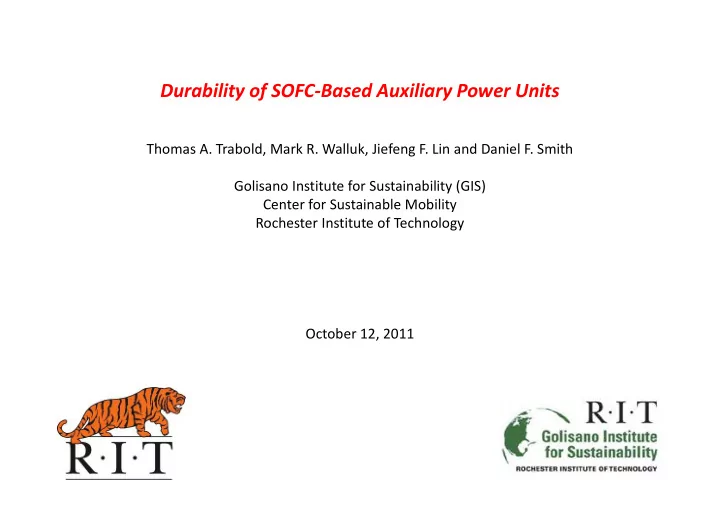

Durability of SOFC-Based Auxiliary Power Units Thomas A. Trabold, Mark R. Walluk, Jiefeng F. Lin and Daniel F. Smith Golisano Institute for Sustainability (GIS) Center for Sustainable Mobility Rochester Institute of Technology October 12, 2011
Auxiliary power for mobile applications Heavy-duty trucks produce most of their GHG emissions during long idling periods, and as a result 31 states have passed anti-idling laws. Solid oxide fuel cells (3-5 kW) are considered a possible solution, but the diesel fuel must first be reformed on-board into H 2 & CO for supply to the anode side of the stack. L. Gaines et al ., Argonne National Laboratory (2010)
Solid oxide fuel cells (SOFCs) vs. Polymer electrolyte membrane fuel cells (PEMFCs) Characteristic SOFC PEMFC Temperature 800°C 80°C Fuel Reformed hydrocarbon (H 2 + CO) Pure H 2 Materials Expensive (e.g., Inconel) Cheaper (lower-grade SS) Catalysts Mixed PGM and non-PGM Pt-alloy Start-Up Slow (hours) Fast (minutes or seconds) Applications • Stationary power (CHP) • Emergency back-up power • Auxiliary power units for heavy- • Automotive propulsion duty trucks
Dominant degradation mode: Solid carbon (soot) formation during diesel reforming Equilibrium analysis: Modeling based on minimization of Gibbs free energy predicts “ideal” fuel conversion if all reactions proceed to thermodynamic equilibrium. Predictions indicate that carbon formation would be severe during start-up transient when temperature is below normal operating condition (NOC)
Single-tube reformer experiments used to measure carbon during thermal transients A single-tube reformer enables empirical studies of the sensitivity of the reforming process to key system control parameters: air flow, fuel flow, recycle rate, temperature, etc. Direct Measurement of Carbon Concentration Lin, J., Trabold, T.A. and Walluk, M.R., “Reformer air control to mitigate carbon formation during diesel reforming for solid oxide fuel cells,” in preparation for submission to Journal of Power Sources ( 2011). W. Schindler et al., SAE Paper 2004-01-0968 (2004)
Correlation between ethylene and carbon concentrations Previous research described ethylene formation as a result of thermal decomposition of diesel, followed by carbon formation via heterogeneous reaction within the reformer. Our novel results showed a strong correlation, with a transition around a critical value of [C 2 H 4 ] = 0.8%. Trabold, T.A., Lylak, J., Walluk, M.R., Lin, J. and Troiani, D., “Measurement and analysis of carbon formation during diesel reforming for solid oxide fuel cells,” submitted for publication to International Journal of Hydrogen Energy (2011).
Fundamental understanding applied to full APU system Test hypotheses developed from simplified analysis and experiments on full fuel reformer sub-system and production-intent APU system Smith, D.F., Trabold, T.A., Walluk, M.R., Wodenscheck, J., Haselkorn, M. and Nasr, N., “Accelerating the Transition of Fuel Cell Systems,” Final Report, TARDEC Contract W56HZV-08-C-0671 (2011).
Apply same methodology to waste-derived bio-fuel and bio/petro blend systems Apply economic analysis and life-cycle assessment (LCA) to select among technology pathways to minimize GHG emissions and maximize value Table 1 – Locally available bio-fuels assessed in the present study Fuel Approx. lower heating value Need to consider Need to consider (kJ/g) sulfur content water content × × × × Ultra-low sulfur diesel , 42.3 ULSD (baseline) × × × × × × × × Bio-diesel from grease 38.9 × × × × Ethanol from corn silage 27.0 × × × × Bio-butanol 34.4 × × × × × × × × Compressed bio-gas 23.0 (assumed 70% methane) Lin, J., Smith, D.F., Babbitt, C.W. and Trabold, T.A., “Assessment of bio-fuel options for solid oxide fuel cell- based auxiliary power units,” Proceedings of the IEEE International Symposium on Sustainable Systems and Technology (ISSST), Chicago, May 2011.
The Center for Sustainable Mobility will be housed in the Golisano Institute for Sustainability building, currently under construction with completion by September 2012. Research programs covering areas of future mobility and energy system technologies, including: bio-fuels, fuel cells and batteries
Recommend
More recommend